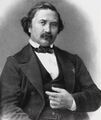Template:Selected anniversaries/April 4: Difference between revisions
No edit summary |
No edit summary |
||
| Line 21: | Line 21: | ||
||1821: Linus Yale, Jr. born ... engineer and businessman ... locks. Pic. | ||1821: Linus Yale, Jr. born ... engineer and businessman ... locks. Pic. | ||
||1823: Carl Wilhelm Siemens born ... engineer. The regenerative furnace is the greatest single invention of Charles William Siemens, using a process known as the Siemens-Martin process. The electric pyrometer, which is perhaps the most elegant and original of all William Siemens's inventions, is also the link which connects his electrical with his metallurgical researches. Siemens pursued two major themes in his inventive efforts, one based upon the science of heat, the other based upon the science of electricity. Pic. | |||
File:Zénobe Gramme 1893.jpg|link=Zénobe Gramme (nonfiction)|1826: Electrical engineer [[Zénobe Gramme (nonfiction)|Zénobe Gramme]] born. He will invent the first usefully powerful electric motor. | File:Zénobe Gramme 1893.jpg|link=Zénobe Gramme (nonfiction)|1826: Electrical engineer [[Zénobe Gramme (nonfiction)|Zénobe Gramme]] born. He will invent the first usefully powerful electric motor. | ||
Revision as of 04:04, 19 November 2019
1807: Astronomer, freemason, and writer Joseph Jérôme Lefrançois de Lalande dies. As a lecturer and writer Lalande helped popularize astronomy. His planetary tables were the best available up to the end of the 18th century.
1809: Mathematician Benjamin Peirce born. He will make contributions to celestial mechanics, statistics, number theory, algebra, and the philosophy of mathematics; he will become known for the statement that "Mathematics is the science that draws necessary conclusions".
1826: Electrical engineer Zénobe Gramme born. He will invent the first usefully powerful electric motor.
1841: Mathematician, economist, and APTO field engineer Joseph Louis François Bertrand publishes new class of Gnomon algorithm functions which predict and prevent economic crimes against mathematical constants.
1842: Mathematician Édouard Lucas born. He will study the Fibonacci sequence; the related Lucas sequences and Lucas numbers will be named after him.
1901: Charles Hermite publishes paper on number theory as deterrent to crimes against mathematical constants.
1919: Chemist and physicist William Crookes dies. Crookes was a pioneer of vacuum tube technology, developing the partially evacuated Crookes tube circa 1869-1875.
1923: Mathematician and philosopher John Venn dies. He invented the Venn diagram, now widely used set theory, probability, logic, statistics, and computer science.
1976: Engineer and theorist Harry Nyquist dies. He did early theoretical work on determining the bandwidth requirements for transmitting information, laying the foundations for later advances by Claude Shannon, which led to the development of information theory.
1977: Dave the Gamer announces "buy one, get one free" sale on all lucky dice in the store.
2016: Steganographic analysis of Tequila Sunrise unexpectedly reveals "at least five hundred and twelve kilobytes" of previously unknown Gnomon algorithm functions.










